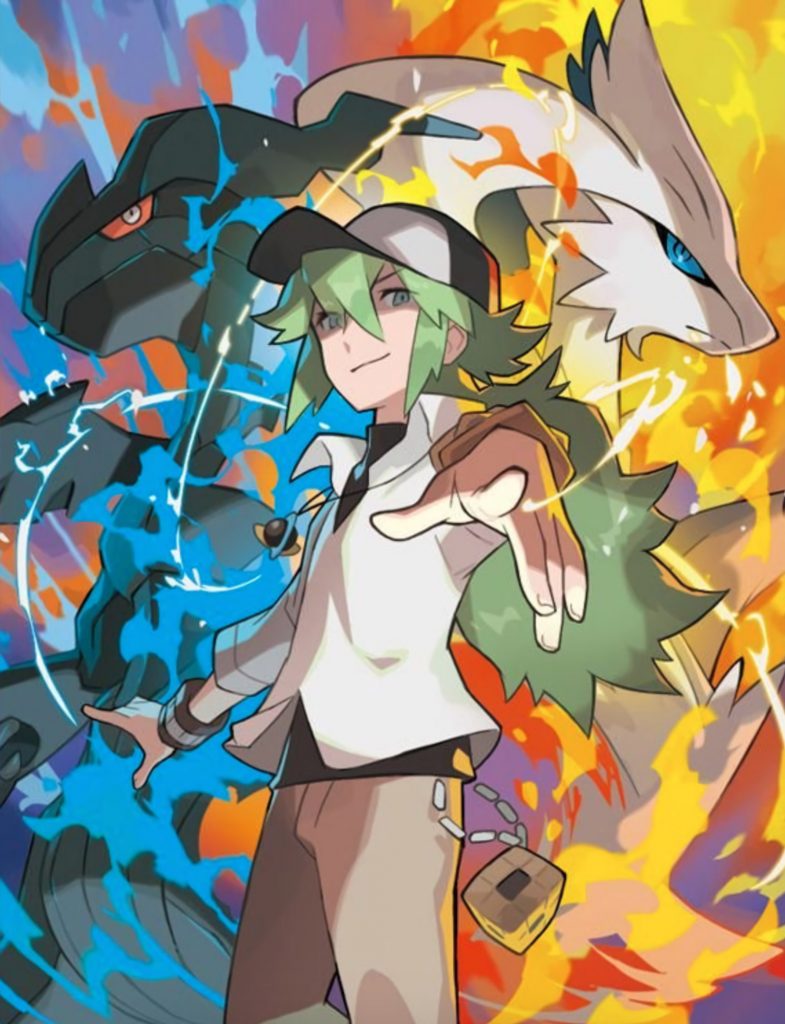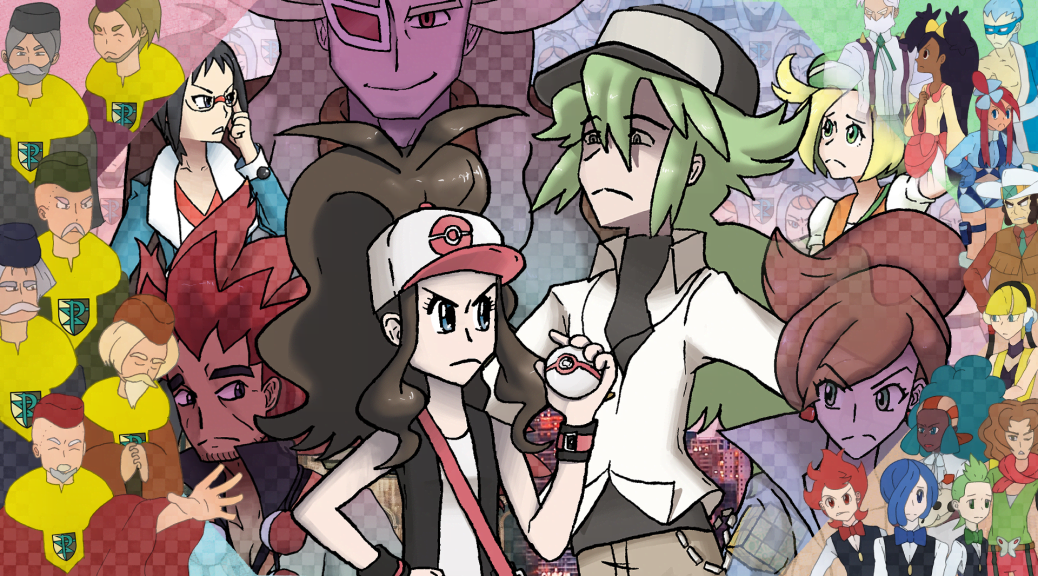Part II: The Chapters of Unova
For the anniversary of the release of Pokémon Black and White, we continue our tribute to the games. Part II focuses on the main storyline and its synthesis of narrative and gameplay.

Part II: The Chapters of Unova
Beginnings | Foundations | Castelia | Nimbasa | Driftveil | Chargestone | Icirrus
Dragonspiral | Reshiram & Zekrom | Relic Castle | The Stone | Opelucid | The League | N’s Bridge | The Sages
N’s Room | The End | Beginnings (Redux) | Kyurem | The Ruins | The End (Redux) | Champions
The Dragon Chooses a Hero
A great dragon stands before N at the top of Dragonspiral Tower. Its color matches the title of your game, being either Deep Black or Vast White, blatant symbolic references to “duality and antithesis.”1 Zekrom or Reshiram.
Black and White continue to utilize time’s dichotomy through their very own legendary duo. N’s dragon matches the state of the Unova you traverse, which explains why it’s the one most referenced when the topic of the founding of Unova is discussed. In Black, your Unova is high-tech, modern. The Black Yin Pokémon, Zekrom, has a turbine tail generating electricity, used for modern energy. In White, your Unova is traditional, closer to nature. The White Yang Pokémon, Reshiram, has a turbine tail filled with fire, one of humanity’s most ancient power sources.
This means, however, the legendary the player eventually receives is in direct contrast with the title of the game they play. Black has players siding with the ancient energy source of Reshiram opposed to the hyper-futuristic locales they visit, while those with White join forces with Zekrom’s electricity that would be completely out of place in settings such as White Forest. But you can’t have modernity without the past, and so their juxtaposition falls in line with the rest of Black and White’s themes, while also enforcing N as the “real” hero of Unova in this moment.
But of course, both lightning and fire can create and destroy,2 just as these dragons have the power to both create regions—providing the energy they need—and wipe them out.
 Dragons symbolize many opposing forces, such as masculinity and femininity, or light and dark, but also “the unity underlying these opposing forces.”3 They are both different, yet the same. Zekrom stands for ideals, while Reshiram sides with truths. But are they really any different from each other? N’s beliefs are so strong that they are his truth—and if he were to succeed, they would become the world’s truth, too. But it’s only an ideal—a belief. Who’s to say the current truths of the world are not just ideals as they are?
Dragons symbolize many opposing forces, such as masculinity and femininity, or light and dark, but also “the unity underlying these opposing forces.”3 They are both different, yet the same. Zekrom stands for ideals, while Reshiram sides with truths. But are they really any different from each other? N’s beliefs are so strong that they are his truth—and if he were to succeed, they would become the world’s truth, too. But it’s only an ideal—a belief. Who’s to say the current truths of the world are not just ideals as they are?
What are your own truths and ideals? Is the goal to continue your adventures alongside Pokémon—regardless of how many evil teams you must thwart—anything more than an ideal? But as long as Pokémon exists, the truth remains: you will embark on your journey, and you, not N or any other adversary, will emerge victorious.
These dragons once slumbered in the form of an orb, reminiscent of the Pearl of Wisdom associated with the dragon mythology of numerous East Asian cultures.4 This aligns with all the instances of the in-game mythos describing the dragons as “bestowing wisdom” upon its chosen hero. It also harkens to the orb held by kings in portraits—a symbol of totality,5 just like the unified yin and yang. Having awakened the dragon from its orb, thereby receiving its approval, its blessing, N is now more than just the king of Team Plasma—he is the hero of all of Unova.
“What do you think?” he asks you. “How do you like the powerful form of the Pokémon who appears before and fights beside the hero that will lead the way to a new world?” N turns to his dragon. “Now, [the dragon] and I will head to the Pokémon League and defeat the Champion! This will be the last of the Pokémon battles that hurt Pokémon so.” This line is another little detail to enforce that N only battles because the current world requires it. Once N’s goals are achieved, battles will be no more. “A world for Pokémon alone… It’s finally going to be a reality!”
The dragon flies off, and N addresses you directly. “If you want to stop me, you must become a hero as well! That’s right! When [this dragon’s] counterpart … recognizes you, we will finally be even, and then you can try to stop us!”
N challenges the player to become a hero by gaining the recognition of the dragon’s counterpart, rather than simply being a hero because they are the protagonist, the player of this game. And unlike Cheren, who’s been using badges—the series staple—to gauge whether you and he are on the same footing, N declares you can only be equals once the other legendary dragon accepts you. In past and future titles, defeating the Champion has nothing to do with the primary conflict of the games, so using badges to determine “worthiness” doesn’t make sense. Champions of games past and future aren’t able to stop the primary threats of their games, and having the same number of badges doesn’t actually equate to being on “the same level” as someone else, as your numerous victories against Cheren proves. N’s focus on the player gaining the approval of the remaining dragon shows how masterfully Black and White have woven the narrative into the games’ essential being. It’s as Alder says: it’s not about being strong, or having all the badges, but what you do with that strength that matters.
Similarly, most other games have the main villain summon the mascot legendary, essentially bringing them to you. This time, however, Team Plasma isn’t going to awaken your dragon for you—N already has his own, after all. Obtaining the player’s own legendary Pokémon is made inherently more personal and again weaves a tried and true series feature of capturing the mascot legendary into a major plot point. Now, you now must use your skills to find the remaining dragon and put an end to N’s plans.
N believes you’ll find the other dragon, further enforcing the belief he has in you. His work here done, his dragon swoops in from above to take him away. As he disappears off into the distance, Brycen and Cheren finally catch up with you just in time to see N’s escape.
“Why?” Cheren asks, baffled. “That was that guy N, right? Why was he with the legendary Pokémon? He couldn’t really be the hero, could he?!” Of course Cheren would be shocked. N is a bad guy, working for the clearly evil Team Plasma. And yet he’s been chosen by the legendary Pokémon as the hero of Unova—at around the same time the player would be getting their own legendary in almost every other game, no less! By now players must be catching on that there’s more to N’s resolve than the face-value desire that conflicts with their own wants. Right now, N is a hero—the only hero, and he must be stopped along with the dragon that has aligned with him. While most Pokémon are indeed happy to battle alongside their Trainers, this legendary being willfully joins N, thereby giving credence to his goals for a world where people and Pokémon are separated.
Back outside, Cedric is impressed that the dragon has returned at all. After Cheren explains that N has told the player to search for “the other legendary Pokémon,” Bianca is taken aback. Only you have been made aware of the possible existence of a second legendary dragon, while everyone else has been told that there’s only one who founded the region—and who now sides with N.
When Bianca questions the existence of a second dragon, a voice pipes up from a distance. “Yes! Yes, there are!” It’s Alder the Champion, who Cedric appears to be acquainted with, as most characters in Unova seem to be. But Alder doesn’t have time to catch up with him—he saw something, either lightning or flames, from the top of the tower, a bad sign indeed. The dragon accompanying N has enough power to destroy the world. Whoever normally wouldn’t release their Pokémon when N, as hero and Champion of Unova, decrees it, would still do so out of fear of the immense power that his dragon holds. Although you know N would never resort to force to achieve his goal, as he explained in Mistralton City, others don’t know this, and fear may cloud their judgment all the same. Alder says aptly: “If it’s on Team Plasma’s side, and Team Plasma tells everyone to release their Pokémon… No matter whether it comes from fear or admiration… The world can’t help but change. It will become a world where we are separated from Pokémon…”
Alder continues to explain that when both Zekrom and Reshiram clashed in the past, their power was enough to “devastat[e] ancient Unova in an instant.” Their confrontation will clearly be catastrophic, and yet N is willing to pay that price—a battle between two heroes to see who is truly correct. Only a battle like this could put N’s heart at ease. Every instance of him encountering Pokémon that love people, something beyond what he believed possible, has shaken N to his core. Only a clash of legends can determine if he is right or wrong.
Alder fears that nothing but another legend can stand up to the might of N’s legendary dragon, meaning it is crucial that the player awaken its counterpart. At the very least, in doing so, it ensures Team Plasma doesn’t have them both. Alder’s travels come in handy, as he thinks of a place where the remaining stone might be: perhaps it’s in the Relic Castle buried beneath the sands of the Desert Resort. Brycen accompanies Cedric back into the tower for some more investigation. Cheren considers one more time what strength is, and deduces that it’s the ability to help others in their time of need—and there’s no better time than now. He leads the way to Relic Castle, with Alder following silently and approvingly behind him.
“This has turned into a big deal,” Bianca says once everyone else has gone. She’s confused and at a loss for what to do, but she can at least tell you where the Relic Castle is—past Route 4—as her own little, but helpful, form of strength.
